
This site celebrates the life and work of sculptor John
Cassidy (1860 - 1939).
During the cotton boom of the 19th century it grew from a village to a prosperous town: By 1929, it is said that there were 216 cotton mills and 26 bleaching and dying works within the borough. Samuel Crompton (1753-1827), inventor of the 'spinning mule', a machine to spin cotton into thread, was born in Bolton.
Another famous son of Bolton was William Hesketh Lever, later the first Viscount Leverhulme; when ennobled he added the surname of his wife Elizabeth Hulme, also born in Bolton, to his own name. He made a fortune in the soap industry, his name surviving today in the multinational congolmerate Unilever. He was a man of great ideas: among many other things, he 'wanted to completely redesign Bolton town centre but his offer was not accepted by the council.'
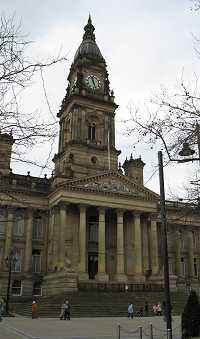
Like the other Victorian textile towns, the manufacturers and their corporation expressed their wealth with large public buildings, of which Bolton town hall, presiding over an expansive open space, is a classic example, designed by William Hill and opened by Prince Edward (Prince of Wales, later King Edward VII) and Princess Alexandra in 1873.

Among the adornments of this square is Cassidy's bronze statue of Sir Benjamin Dobson.
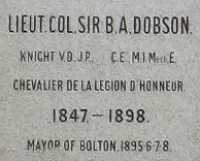
Sadly, like most of the other textile towns in Britain, Bolton found that by the 1960s its industries were unable to compete with cheap foreign imports, and its industry went into severe decline; by 1979 only eight mills remained, and in the 21st century there is no textile manufacturing in the town at all. However, it has recovered well from this blow, thanks to new industries and the demand for higher education sector which has led tothe creation of the University of Bolton. Visitors to the town centre will find a general air of prosperity.
Bolton has the distinction of having two Cassidy large works on open-air display. The second, a stone statue of James Dorrian, is set in the rural surroundings of Queen's Park outside the town centre; a public park was another feature that the cotton town burghers considered an essential feature of the ideal manufacturing town.
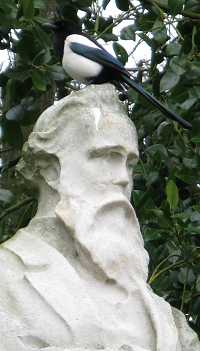
The park, built on the valley slope of the river Croal, was opened in 1866 at the height of the Victorian era. The 'terrace' is at the highest part of the park, and seems to have used as a place for statues deemed not important enough for Victoria Square; Benjamin Disraeli (statue by T.P. Rawcliffe of Chorley) and J.P. Fielding line up with Dr Dorrian.
The park was originally called Bolton Park; in honour of Queen Victoria's Diamond Jubilee year it was renamed Queen's Park in 1897.
In 1864 William Henderson from Birkenhead (who also designed parks in Oldham and Blackburn) prepared plans for the park. In November 1864 the land was purchased from The Ecclesiastical Commissioners, a Miss Pilkington, and the estate of a Mr Tipping.
There was a museum in the park, known as Chadwick's Museum, an ornate structure opened in 1884 thanks to a bequest of £5000 to the Council by Dr Samuel Chadwick (whose statue can be found in Victoria Square opposite Sir Benjamin Dobson, who chaired the sub-committee concerned with overseeing the building of the museum). The Museum closed in 1955, and the building was demolished in 1957. Its exhibits, including many Egyptian antiquities, collected by Annie Barlow, daughter of a Bolton mill owner, had been transferred to the new Civic Centre and Museum in the town centre.
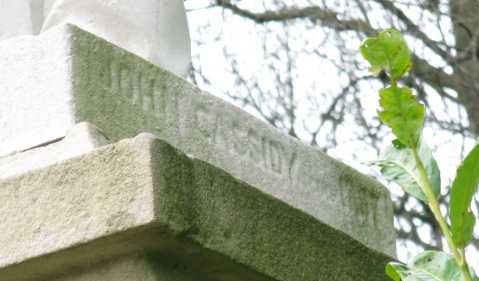
At the time of our visit in April 2008 it was very quiet, with just a few dog-walkers about, and had a rather neglected air. However, in April 2008 Bolton Council received an award of four million pounds from the Heritage Lottery Fund to restore the park, so we can expect better things in the future. The application for lottery funding tells us that 'It was built by a workforce of unemployed cotton workers during the Cotton Famine, one of the four such parks in northern England (the other three, in Oldham, Blackburn and Halifax, have all been restored using Heritage Lottery Fund monies). The park brought pride to the town, gave employment to many otherwise destitute men and provided a tremendous amenity for Bolton’s citizens.'
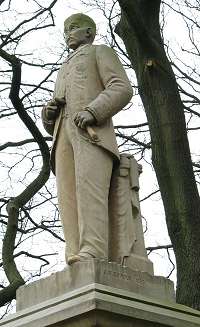
J.P. Fielding, by J.W. Bowden.
Links and references:
John Pennington Thomasson: also on our site, plaques by Cassidy at Mere Hall, Bolton.
Sir Benjamin Alfred Dobson, from the fascinating site 'Links in a Chain, the Mayors of Bolton' - contains much more about Dobson, including the photograph which was almost certainly used as the model for the statue.
Dobson and Barlow, article by St Marks School
Benjamin Dobson, by D.A. Farnie.
Holden, Grayson. 'Dobson and Barlow and the Bolton engineers' strike of 1887'. Manchester Region History Review, 3:2 (1989-90), 15-20.
Friends of Queens Park, Bolton
Bolton from Queens Park, oil painting by Samuel Towers, c. 1925. (Bolton Museums)
www.bolton.org.uk: an excellent site dedicated to Bolton and its history and people.
Bolton: A Tale of Two Statues
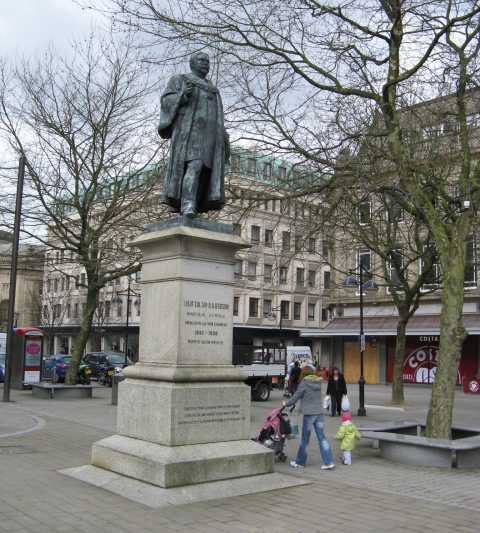
Cassidy's statue of Sir Benjamin Dobson stands, as it has since unveiling, on its granite plinth in the corner of busy Victoria Square, framed by trees and stone buildings. The square, once the market place, is now free of traffic, having been 'pedestrianised' in 1971, making it a pleasant place to visit. Dobson died on 4 March 1898, and soon afterwards a memorial committee was formed to choose a suitable monument to the man. Cassidy, by then a well-known figure in the Manchester area, was chosen, from a short list of five, to create a statue of the late Mayor, to be paid for by public subscription. Whether the choice was influenced by the fact that it was Alderman Cassidy (no relation as far as we know) who first summoned the committee we cannot say. John Cassidy was already known in the town for his sculpture of James Dorrian (see below), unveiled in January 1898.
The larger than life-size figure, 2.44 metres high, depicts Sir Benjamin as Mayor of Bolton, wearing the robes and chain of office, in a somewhat pensive mood, holding his monocle in his right hand. It has been described as 'one of Cassidy’s strongest full-length statues' A clay model had been viewed and approved at Cassidy's Lincoln Grove studio by members of Sir Benjamin's family as well as the memorial committee. The bronze casting was by Singers of Frome, Somerset, who are known for their work on the bronze features of the John Rylands Library in Manchester.
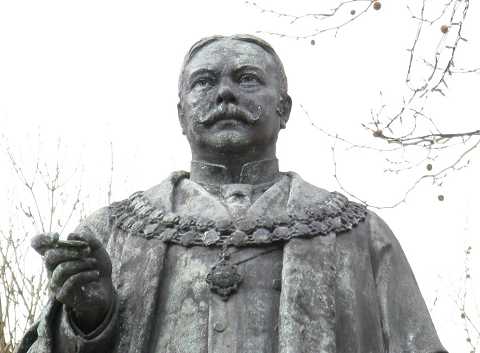
Benjamin Alfred Dobson was an archetypal Victorian hero figure. Born in 1847 at Douglas on the Isle of Man, he was the son of an engineer. After attending Carlisle Grammar School, he studied at the Collegiate Institute in Belfast before taking up an engineering post with the Belfast and Northern Counties Railway. In 1869 he moved to Bolton to join the family firm of textile machinery manufacturers, which had been was founded in 1790 by Isaac Dobson (1767-1833) and Peter Rothwell (d. 1816). Douglas Farnie relates that:
[The business] was carried on by
the nephew of the founder, Benjamin Dobson (1787–1839), and then by his
son, Benjamin Dobson (1823–1874), who took Edward Barlow (1821–1868)
into partnership in 1851. After Barlow's death it continued to trade as
Dobson and Barlow. As the great-grandson of Isaac Dobson's brother,
Benjamin Alfred was the fourth generation of the family in the
business. On the retirement of his uncle in 1871 he became a partner,
together with Thomas Henry Rushton (1845–1903), the son of Thomas Lever
Rushton (1810–1883), a banker and erstwhile ironfounder.
The firm expanded in the latter part of the nineteenth century, employing over 5000 workers by 1898, and Dobson amassed a considerable fortune. He published books and technical papers on cotton spinning and engineering, and export of his machinery led to his being made a Chevalier de la Legion d'Honneur by the French government. He became a member of the Institution of Mechanical Engineers in 1872 and served as a member of its council from 1885 to 1891 and again from 1893 to 1894. He personally patented twenty-two inventions between 1877 and 1897, and travelled widely on behalf of the firm. In 1886 he bought the Doffcocker estate, just outside Bolton, and later another estate at Haverthwaite in Westmorland. The firm later lost the family name through a series of amalgamations, and was eventually closed in 1984, in the death throes of the British cotton industry.
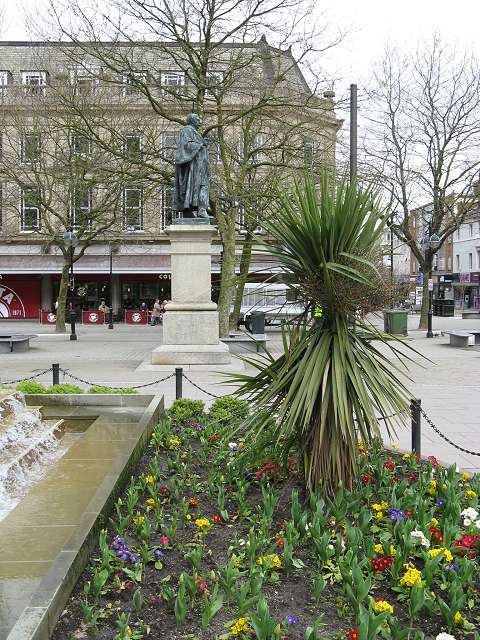
Like many such men, Dobson was said to be 'beloved by his workpeople'; in 1871, the year he arrived in Bolton, the company introduced a nine-hour working day, to great celebration by the workers. Later, however, he brought in new workers to break a strike in 1887, and refusing to deal with the engineers' trade union. He also took up politics, becoming a town councillor in 1874 and Mayor of Bolton in 1894. He served as a Justice of the Peace, and held other public posts including Lieutenant-Colonel of the 2nd Volunteer Batallion, Loyal North Lancashire Regiment. He supported the establishment of a Technical School in Bolton, equipping it with machines from his factory.
He died suddenly in 1898 at the age of just 50, leaving £240,134 in his will, and was buried at St Peter's Church, Smithills, Bolton, large crowds attending his funeral.
Dr James Dorrian
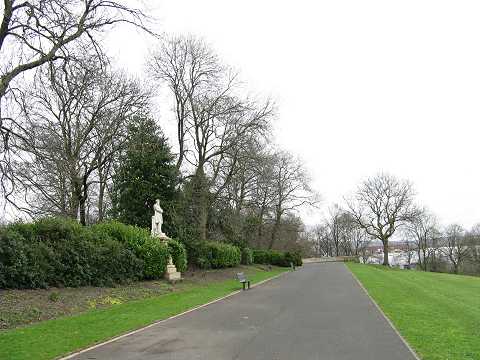
Bolton's other Cassidy memorial, the statue of Dr James Dorrian, stands in very different surroundings on the terrace of Queen's Park, just north-east of the town centre.
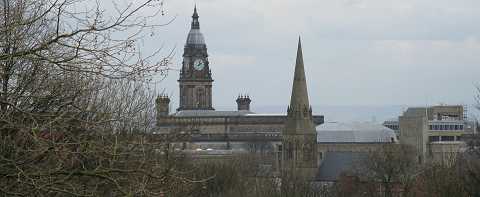
The picture above shows the view from the terrace down towards the Town Hall with is 61-metre-high clock tower, and Bolton's other civic buildings.

The statue, unveiled on 29 January 1898, shows Dr Dorrian in Victorian clothes, holding a book. The inscription, surrounded by a wreath, reads:
JAMES DORRIAN.M.D.
1826-1895
ERECTED BY
PUBLIC SUBSCRIPTION
TO COMMEMORATE
A LIFE OF
USEFULNESS
1826-1895
ERECTED BY
PUBLIC SUBSCRIPTION
TO COMMEMORATE
A LIFE OF
USEFULNESS
Who wouldn't like to be remembered as having had a 'life of usefulness'?
It is executed in Portland stone, a much cheaper medium that bronze, as the work would have been completed in Cassidy's studio with no need to call on the services of a foundry. Sadly, this famous limestone proved less resistant to the acid fumes emitted by the surrounding factories and textile mills as might have been hoped (see also Ben Brierley) and the face and beard have become a little eroded, although the good Doctor has fared better than J.P. Fielding, scuplted by J.W. Bowden in 1896, whose head now looks more like that of the legendary alien from outer space than a respectable Victorian trade unionist.
James Dorrian was doctor born in County Down, Ireland, and educated in Dublin. He came to Bolton around 1850, gaining a reputation for charity and philanthropy through ministering to the Irish poor.
The history of the statue is described by the Public Monument and Sculpture Association National Recording Project:
About a year after Dorrian's
death a public
meeting was called by the Deputy Mayor, Alderman Nicholson. It was
resolved that Dorian's "self-sacrificing devotion and unfailing
charity" be recognised by a statue to be placed on the north side of
Victoria Square. A committee was established and a subscription list
opened amongst the trade and other societies in the town the responses
to which indicated "the esteem and veneration in which the benevolent
doctor was held." Estimates for the statue were obtained, the
commission going to Cassidy, whose stone statue was "of heroic
proportions." There was some dispute over its siting, which touched on
some sensitive subjects, and appeared to divide the council between
Dorrian's Anglo-Irish champions and the other councillors. At a meeting
of the General Purposes Committee in September 1897, Councillor Kearns
sought to obtain a site for the statue in Victoria Square. Referring to
the recently-erected statue of trade unionist John Fielding, he said
that it would be better to site the Dorrian memorial outside the park
because otherwise "some day or other they would have the Park filled
with little piecers and all classes of statues, if it was allowed to be
used for that purpose." Councillor Maginnis seconded Kearns'
amendment, arguing that Dorrian had just as much claim to space in the
square as the statue of the Anglican doctor and philanthropist Samuel
Chadwick (erected 1873). Dorrian's charity was more than the equal of
Chadwick's, Maginnis claimed, since the latter "was devoted to one
section," meaning members of the Church of England. The Mayor concluded
by saying that it would "be a mistake to open the door to filling the
square with statuary" and that a stone statue would be out of place.
The amendment was lost and Dorrian took up residence on the Park
Terrace.
To which we have little to add. Can anyone tell us more about the life and career of Dr Dorrian?
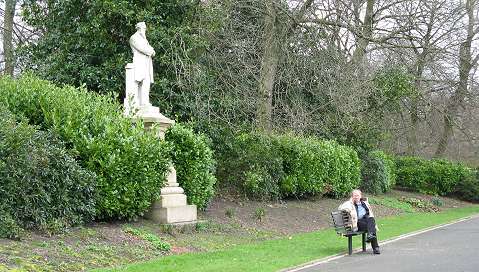
Dr Dorrian and the author, April 2008.
We dedicate this page to the memory of Professor Douglas Antony Farnie, historian of the Lancashire textile industry, who died on 21 June 2008, aged 82, while this feature was in preparation.
Page created by Charlie Hulme, July 2008. Updated July 2009